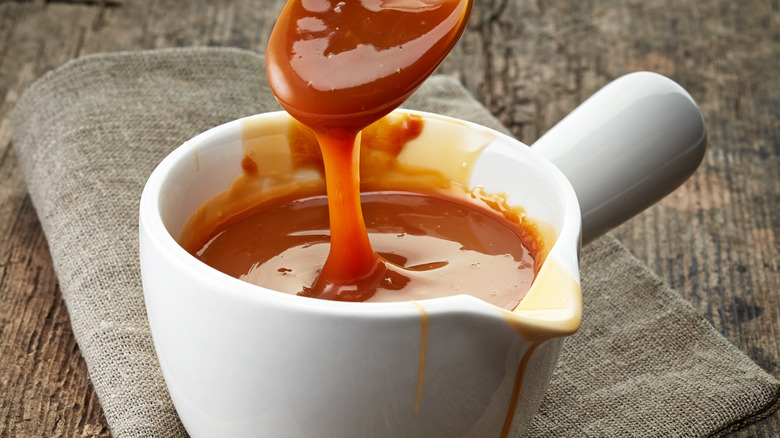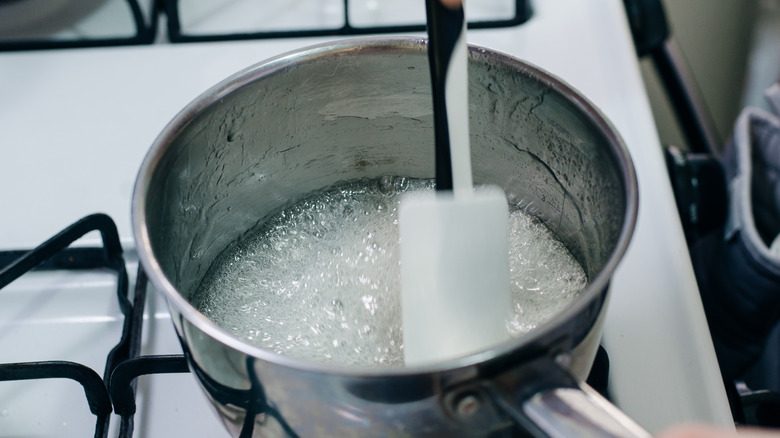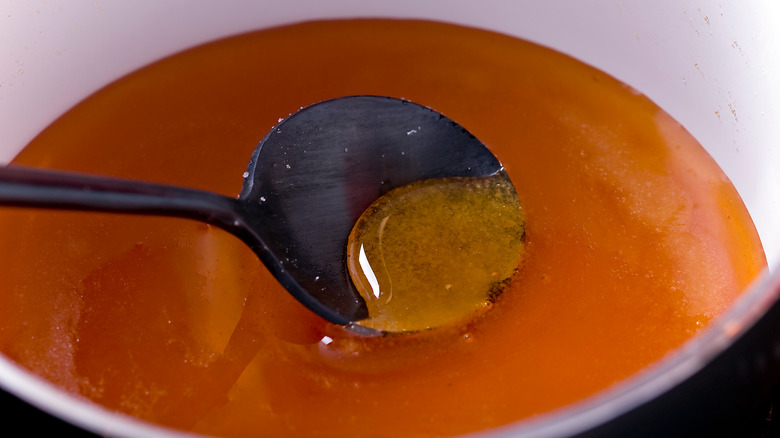The Clever Pot Picking Tip For Effortlessly Better Caramel
Following a caramel recipe requires a mindful approach — the bubbling sugar mixture is as hot as lava and notoriously easy to burn. Still, many cooks agree that making this confection from scratch is deliciously satisfying and undoubtedly worth your time, and with the right tools at hand, your chances of failure go down. This includes a white or light-colored pan.
Caramel-making is all about precision (with a pinch of patience). Home cooks must follow the recipe exactly and keep the melted sugar at the right temperature. Candy thermometers are helpful for first-timers, but as you become more skilled, you'll spend less time watching the thermometer and more time assessing the color of the caramel. As the sugar melts, it changes from transparent to increasingly darker shades of brown. The hue helps you assess which of the seven stages of caramelization the sugar has reached.
This is why using a pot with a white or light-colored interior is critical. A black pot makes the mixture seem darker than it really is, so you can't tell if it's burning or not, while other colors will distort the hues you're looking for. A white background displays the caramel's shade most precisely, so you can judge when it's at the stage you want, whether you're making chewy candies or a caramel sauce for a dessert charcuterie board. A pot with a heavy bottom and tall sides is good, too, since this helps the sugar cook evenly and prevents overflow as it bubbles up.
Use your senses when preparing caramel
With so many variables at work in the caramel-making process, it's helpful to use all the tools at your disposal, including your senses. Candy-making rules define seven stages of cooked sugar, and if you don't have a thermometer, it can be difficult to differentiate these stages by visuals alone. You might not be able to tell the difference between the "hard ball" and "hard crack" stages when making caramel taffy, resulting in overly brittle candies. Luckily, your sense of smell and taste can also help you judge the sugar's doneness.
Just as the caramel's color deepens and becomes richer as it cooks, so do its taste and smell. As the sugar molecules break down to create new flavor compounds, the scent rising up from the pot will change. Light caramel smells like cotton candy, but becomes richer and nuttier over time. At the end of the spectrum is a sour-smelling caramel that's black with an acrid taste.
Caramel-making can also be done using a "wet" or "dry" method. Although the wet method takes longer, it provides more protection against burning, so novice candy-makers may want to use it until they get good at judging caramel. And if you get comfortable with a recipe and decide to change it up, such as by adding hot sauce to boost caramel sauce, be mindful that it will look, smell, and behave differently in the pot, so watch it even more closely.
Tips for making caramel
A few more tips can help you avoid common caramel pitfalls. Firstly, bide your time. Melted sugar takes a few minutes to reach the thread stage (in which it thickens enough to form thin "threads" when stirred), but the process speeds up afterward. It's best to cook caramel over low heat rather than trying to speed up the process over high.
Additionally, resist the instinct to stir the pot — once the sugar melts, excessive stirring can lead to crystallization, which creates a gritty texture, as if you had dropped your caramel in sand. Instead, try Carla Hall's lid tip for homemade caramel to keep the sides of your pot clean. Avoid making caramel in a humid environment, since the sugar might absorb ambient moisture and won't caramelize properly. Pick a day when the weather is cool and dry. And don't assume you can double your recipe unless it says you can, as a larger volume of sugar doesn't always cook the same way.
Pay attention to the type of sugar in your recipe, as well, as different types boil and caramelize at different rates. If you'd like to incorporate brown sugar, find a recipe that uses it, instead of forcing it on a recipe that uses white sugar. And even if you're making salted caramel, use unsalted butter. Some brands are saltier than others, so it's easy for your candy to wind up over-salted.



